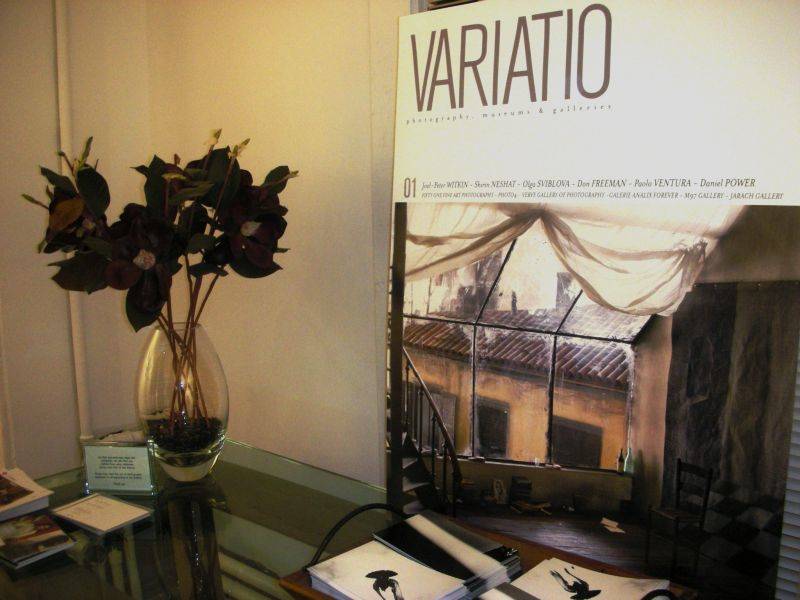Variations on a Theme: Watching and Photographing the World from New Points of View
At the Leica Gallery, the space that houses the history and legend of Leica, the camera that portrayed humanity in a new way, there is currently an exhibition of powerful work by Renato D’Agostin and Alessandro Zuek Simonetti. On Thursday, December 10 the Leica Gallery held the opening reception for Variatio, a new bimonthly magazine dedicated to photographic art. We want to emphasize that this is an artistic undertaking in the most honest and complex sense of the word.
This is not the usual photography magazine to which the public is accustomed –those with large print-runs and few ideas. Variatio has a mission: to document and describe the evolution, or revolution, of art photography in the world. Publishing six issues each year and attracting fans through the unstable dynamics of inspiration, from the research to the creation of images. It is, perhaps, surprising to discover that different artists, on opposite sides of the world, live within the same poetics and this poetic is not random but rather it is the energy of art.
Professor Renato Miracco, editor-in-chief of Variatio, explains why he wanted to open the first issue with a quote from Robert Frank, an artist whose work is currently on display at the Met. The reason is twofold: in addition to paying homage to a great photographer, Miracco recognizes the synthesis between the revolution wrought by Frank in the ‘50s and ‘60s and the one which Variatio and its artists hope to inspire by breaking the accepted rules and capturing reality in new ways. Frank reflected America’s true face back to itself. Without smoke and mirrors, he chose to get closer – we could say with the eye of a neo-realist – to the defects, the cracks in an imperfect dream. Positioning Variatio in Robert Frank’s footsteps signifies to the world that it is still possible to experiment with innovation. It is an incentive to embark on a new path, and the challenge, or privilege, for Miracco and his team is to find those who can do it in an exceptional way.
Variatio seeks to create a space for the artistic community to meet and exchange ideas that give way to a discussion about photography.
Sacha Majidian is the creative director and project manager of the publication. He tells us how such a difficult and involved project came about. It was born from the end result.
Knowing in advance where the magazine wants to go, who will read it, and who will collect it is the only way to deal responsibly and professionally with a competitive niche. It was clear from the outset that this would be a cult object dedicated to those who truly love and want to understand photography.
The only way to stand out from the many photography magazines that crowd the newsstands is to focus on quality and exceptional work. Five thousand numbered copies will be printed every two months and distributed to galleries and bookstores worldwide, including the U.S., France, Belgium, Italy, and Japan. Each featured artist will be supported and guaranteed by the gallery that represents him or her and whose name and address will be included next to the work. This choice should not be considered a limitation but rather proof of the publication’s seriousness and professionalism.
Speaking of artists, here is the first group of artists who have the honor of inaugurating this trip: Joel-Peter Witkin, Shirin Neshat, Olga Sviblova, Don Freeman, Paulo Ventura, Daniel Power, Renato D'Agostin, Fifty One Fine Art Photography, Photo4, Verve Gallery of Photography, Galerie Analix Forever, M97 Gallery, Jarach Gallery, Power House Arena, and many more. Each issue will feature and in-depth interview with an important photographer in his native language along with an English translation.
Variety, already indicated by its name, is the key to understanding the magazine. Artists with different backgrounds, cultures, and traditions enrich the experience of each issue.
Browsing the magazine will be like traveling, moving from one microcosm to another through the emotion contained within the images, following the art through the changing landscape according to the earth’s motion...and in some cases in contrast to it. And as we said earlier, this will help us find the aesthetic currents and lines of imagination that move together without ever intersecting. Nothing is created and everything is destroyed, but, we might add, everything can be told in new ways through variations on a theme.







































i-Italy
Facebook
Google+
This work may not be reproduced, in whole or in part, without prior written permission.
Questo lavoro non può essere riprodotto, in tutto o in parte, senza permesso scritto.